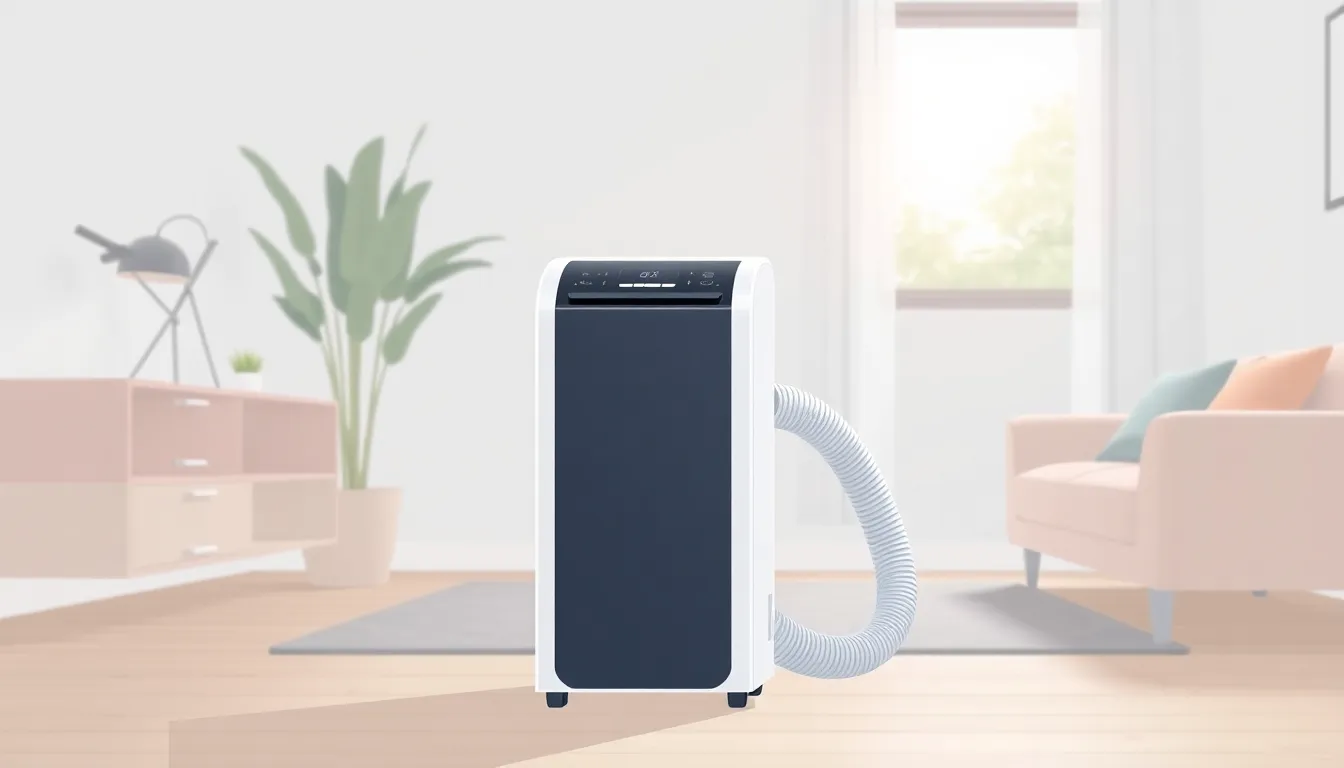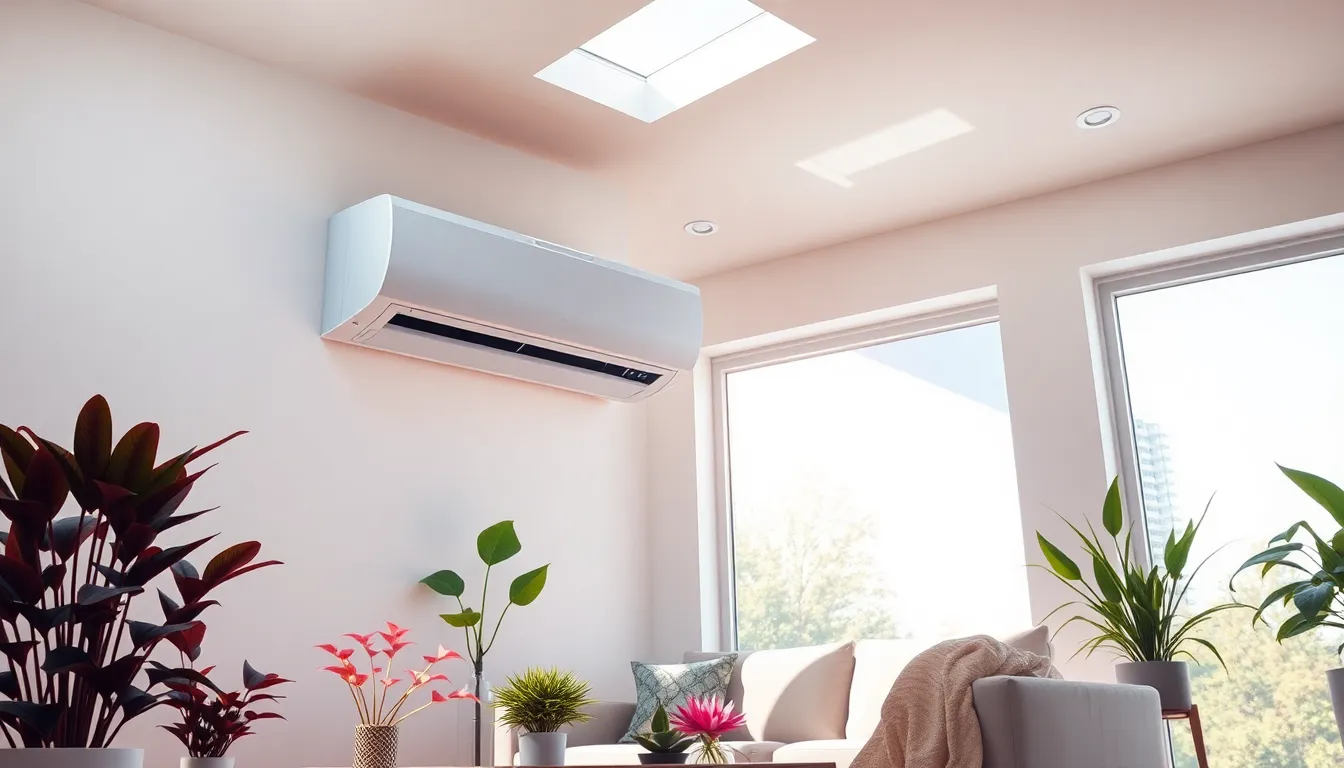When summer hits and the heat cranks up, the last thing anyone wants is to feel like a roast chicken in their own home. But what if your living space doesn’t have a window to let in that sweet, sweet breeze? Fear not! Indoor AC units designed for windowless environments are here to save the day.
Table of Contents
ToggleOverview of Indoor AC Units
Indoor AC units provide essential cooling solutions for spaces without windows. These systems often utilize ductless technology, allowing for easy installation without the need for extensive modifications. Portable models are also available, enabling convenient placement in various locations.
Chillers represent another type of indoor unit, effectively circulating cool air through insulated pipes. Most indoor AC units come equipped with features such as programmable thermostats, timers, and energy-efficient modes. These functionalities enhance user control and optimize energy consumption.
Efficiency ratings, like SEER (Seasonal Energy Efficiency Ratio) and EER (Energy Efficiency Ratio), indicate how effectively a unit cools a space. Higher ratings correlate with lower operating costs, making it beneficial to choose energy-efficient models. Market options vary widely, with brands offering different capacities to accommodate specific room sizes.
Consideration of noise levels also plays a role in the selection process, as many indoor AC units operate quietly, ensuring minimal disruption in living or workspace environments. Maintenance guidelines, including regular filter cleaning and annual servicing, lengthen the lifespan of these systems and ensure optimal performance.
Proper placement maximizes the cooling efficiency of indoor AC units. Installers often recommend positioning units near a central living area or in spaces requiring the most cooling. With numerous models and configurations available, choosing the right indoor AC unit for a windowless environment guarantees comfort during hot summer months.
Types of Indoor AC Units No Window

Indoor air conditioning units without windows come in several types, catering to various needs. Portable air conditioners and split-system air conditioners represent popular choices for maintaining comfort in windowless spaces.
Portable Air Conditioners
Portable air conditioners offer flexibility for cooling different areas. They’re typically compact, making them easily movable from room to room. Many models feature exhaust hoses that vent hot air outside through a small opening, improving cooling efficiency. Users can set programmable timers on portable units to automatically turn on or off, which conserves energy. With energy-efficient designs, these units balance performance and power consumption. Most operate quietly, providing comfort without disruptive noise.
Split-System Air Conditioners
Split-system air conditioners consist of two main components: an indoor and an outdoor unit. The indoor unit circulates cooled air within the room while the outdoor unit expels heat. Installation is straightforward, requiring minimal space compared to traditional systems. Some models incorporate advanced features like Wi-Fi connectivity for remote adjustments, enhancing convenience. Energy efficiency ratings for these systems often exceed industry standards, promoting cost savings in electricity bills. Users appreciate the quiet operation and powerful cooling capacity of split systems, making them ideal for windowless environments.
Benefits of Indoor AC Units No Window
Indoor AC units without windows provide several advantages for maintaining comfort in closed living spaces. These units deliver significant benefits in energy efficiency and space-saving design.
Energy Efficiency
Energy efficiency ranks high among the benefits of indoor AC units without windows. Many models feature advanced technology, which optimizes cooling while minimizing electricity consumption. Seasonal Energy Efficiency Ratio (SEER) ratings often exceed industry standards, indicating superior performance. As a result, users see lower utility bills during hot months. Additionally, energy-saving modes allow adjustments based on occupancy or time of day, further reducing power use. This efficient operation contributes to a reduced carbon footprint, appealing to environmentally conscious consumers.
Space Saving
Space-saving designs characterize indoor AC units designed for windowless settings. Portable units, for example, offer compact solutions that fit seamlessly into any room. These AC units often require minimal installation space, providing flexibility for placement. By eliminating the need for a window, air conditioning installation becomes simple and hassle-free. Split-system air conditioners also save space, allowing for an unobtrusive indoor unit combined with a discreet outdoor compressor. This design maximizes the usable area, which is ideal for small living environments or home offices.
Installation and Maintenance
Installing an indoor AC unit without a window requires careful consideration. Evaluate the space for optimal placement before installation. Ensure proper clearance around the unit to maximize airflow. If using a portable model, identify a location for the exhaust hose to vent outside. For split systems, select a suitable exterior location for the condenser unit. Following the manufacturer’s instructions simplifies the installation process, ensuring reliable performance.
Maintaining indoor AC units hinges on regular upkeep to prolong lifespan. Change filters every 1-3 months, depending on usage, to enhance air quality. Clean the condensate drain line to prevent clogs and humidity issues. Inspect the unit for dust accumulation regularly, using a soft cloth to wipe down surfaces. Schedule annual professional maintenance checks to address potential issues proactively. With these practices in place, users benefit from efficient cooling and improved air quality all season long.
Popular Brands and Models
Leading indoor AC brands offer various models tailored for windowless spaces. LG provides portable air conditioners like the LP0817WSR, known for its efficient cooling and easy installation. Frigidaire features the FFPA1222U1, which combines portability with a user-friendly interface, ideal for small rooms.
Whynter offers models such as the ARC-14S, praised for dual hose technology that enhances cooling efficiency. Honeywell produces units like the MN12CEDBB, featuring a sleek design and programmable settings for optimal control.
Midea showcases the MAP08R1CWT, a compact portable model appreciated for quiet operation and energy-saving features. Black+Decker rounds out the options with the BPACT08WT, which is lightweight and equipped with an easy-to-use remote.
Split-system air conditioners also present robust alternatives. Daikin provides the 19 Series, offering quiet operation, advanced features, and high energy efficiency. Mitsubishi Electric offers the MSZ-GL series, recognized for its superior comfort and customizable settings.
Consumer choices depend on specific needs, such as room size and energy efficiency requirements. Evaluating models based on noise ratings and maintenance needs aids in selecting the right unit. Low maintenance options like self-evaporative systems simplify upkeep while maximizing performance. With various brands and models available, residents can find ideal solutions tailored for their windowless environments.
Finding the right indoor AC unit for a windowless space can transform uncomfortable summer days into a cool retreat. With options like portable and split-system air conditioners, homeowners can enjoy efficient cooling without the need for windows.
By considering factors such as energy efficiency, noise levels, and maintenance requirements, individuals can choose a model that fits their specific needs. Proper installation and regular upkeep ensure optimal performance, allowing for a refreshing indoor environment.
Investing in a quality indoor AC unit not only enhances comfort but also promotes energy savings and improved air quality throughout the season.








